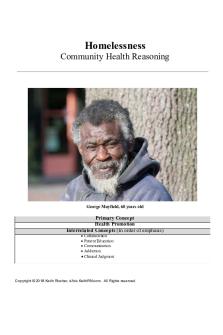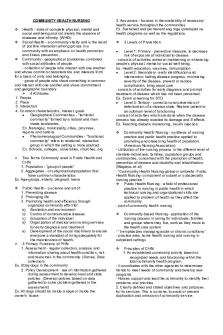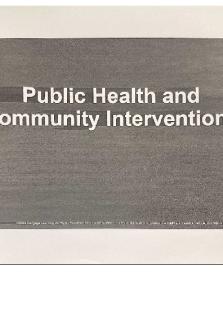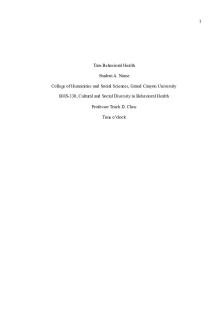Introduction TO Community Health Module-1 PDF

| Title | Introduction TO Community Health Module-1 |
|---|---|
| Author | Purity Makena |
| Course | Community resource management |
| Institution | Machakos University |
| Pages | 52 |
| File Size | 616.9 KB |
| File Type | |
| Total Downloads | 61 |
| Total Views | 453 |
Summary
COMMUNITY HEALTH ANDPRINCIPLES OF COMMUNITY HEALTHMr. Sifuna (BSC.) 0714006400 Smarkmednutritionclinic@gmail1 IntroductionEducation is the key to eradicating extreme poverty around the world. Community education is a process of personal and community transformation, empowerment, challenge, social ch...
Description
COMMUNITY HEALTH AND PRINCIPLES OF COMMUNITY HEALTH Mr. Sifuna (BSC.) 0714006400 [email protected]
1
1.0
Introduction
Education is the key to eradicating extreme poverty around the world. Community education is a process of personal and community transformation, empowerment, challenge, social change and collective responsiveness. It is community-led reflecting and valuing the lived experiences of individuals and their community. Through its ethos and holistic approach community education builds the capacity of groups to engage in developing a social teaching and learning process that is creative, participative and needs-based. Community education is grounded on principles of justice, equality and inclusiveness. It differs from general adult education provision due to its political and radical methodologies. Below are the importances of community education: Community education enables participants to emerge with more than just new personal skills and knowledge; it leads to an increased ability to act as part of a united community for improved social justice. It provides learning opportunities that address the needs of the community and the individual whilst ensuring that the learners' experiences are recognized, valued and used as part of the learning process. The wellbeing of the participants and their community is nurtured during the learning process. This process also ensures that the tutor and participant are on an equal level as the learner identifies the knowledge which would be useful to them and the tutor responds by creating a collaborative, creative learning experience that facilitates and supports learner involvement. The values of community education are put into practice by the group and are promoted locally and nationally: justice, equality and inclusiveness. Community education supports the empowerment of people to identify action that is needed regarding their issues and also to understand why such collective action should be taken. It also supports the challenging of the existing social and economic structures.
Broadly defined, a community is a collection of people who interact with one another and whose common interest or characteristics gives them a sense of unity and belonging. A community is a group of people in defined geographical area with common goal and objective and the potential for interacting with one another. The function of any community includes its members’ sense of belonging and shared identity, values, norms, communication, and supporting behaviors. Some communities may share almost everything, while other communities (large, scattered and composed of individuals) may share only their common interests and involvement in certain goals. A community is often defined by its geographic boundaries and thus called a geographic community. Example, a city, town or neighborhood is a geographic community. A community demarcated by geographic boundaries becomes a clear target for analysis of health needs to form basis for planning health programs and a geographic community is also easily mobilized for action. Community can also be identified by a common interest or goal. A collection of people, although they might be widely scattered geographically, can have an interest or goal that binds the members-together, hence called common interest community. (e.g., Disabled individual scattered throughout a large city may emerge as a community through a common interest in their need for improved wheel chaired access or other handicapped facilities).
The Three Features of a Community 2
A community has three features, location, population and social system. Location: every physical community carries out its daily existence in a specific geographical location. The health of the community is affected by this location, including the placement of services and geographical features. Population: consists of specialized aggregates, but all of the diversed people who live within the boundary of the community. Social system: the various parts of communities’ social system that interact and include the health system, family system, economic system and educational system. Health Health is defined as a state of physical, mental and social well being not merely the absence of disease or infirmity (WHO, 1948). Health, in its holistic philosophy differs greatly from that of the acute care settings. Physical health implies a mechanistic functioning of the body. Mental health means the ability to think clearly and coherently and has to do with your thinking and feeling and how you deal with your problem. A mentally healthy person has a capacity to live with other people, to understand their needs, and to achieve mutually satisfying relationships. Social health refers to the ability to: a. Make and maintain relationship with others. b. Interact well with people and the environment. Health designates the ability to adopt to changing environments to growing up and to aging, to healing when damaged, to suffering and to peaceful expectation of death The ability of a system (e.g. Cell, organism, family, society) to respond adaptively to a wide variety of environmental challenges. Community Health Community health is a major field of study within the medical and clinical sciences which focuses on the maintenance, protection, and improvement of the health status of population groups and communities. The WHO defines community health as: Environmental, social, and economic resources to sustain emotional and physical well being among people in ways that advance their aspirations and satisfy their needs in their unique environment. Community health tends to focus on a defined geographical community. The health characteristics of a community are often examined using geographic information system (GIS) software and public health datasets. Some projects, such as InfoShare or GEOPROJ combine GIS with existing datasets, allowing the general public to examine the characteristics of any given community in participating countries. Health and Wellness Health Each person has a personal perception of health. Some people describe their state of health as good even though they may actually have one or more diagnosed illness (es). That is because each person perceives health in relation to personal expectations and values The concept of health must allow for his individual variability. Health is a dynamic state in which the person is constantly adapting to changes in the internal and external environments. 3
For example, a person may see himself/herself as healthy while experiencing a respiratory infection. Wellness Wellness is a life – style aimed at achieving physical, emotional, intellectual, spiritual and environmental well being. The use of wellness measures can increase stamina, energy and self – esteem, then enhance quality of life. The concept of wellness also allows for individual variability. Wellness can be thought of a balance of the physical, emotional, psychological, social and spiritual aspects of aperson’s life. This is a dynamic state. Each person would define wellness in relation to personal expectations. Wellness behaviors are those that promote healthy functioning and help prevent illness. These include, for example, stress management, nutritional awareness, and physical fitness. MODELS OF HEALTH There are various models of the concept of health. Some models are based narrowly on the presence or absence of definable illness. Others are based more conceptually on health beliefs, wellness and holism. A. Clinical Model (Dunn, 1961) In this model, health is interpreted as the absence of signs and symptoms of disease or injury; thus the opposite of health is disease. Dunn defined, in this model, “health as a relatively passive state of freedom from illness, and a condition of relative homeostasis.” Illness is therefore, something that happens to a person. Many health care providers focus on the belief of signs and symptoms of disease and conclude that when these are no longer present, the person is healthy. N.B. This model may not take into consideration person’s health beliefs or person life- styles. B. Host –Agent – Environment Model (Leavell, 1965) This model helps to identify the cause of an illness. In this model: Host: Refers to the person (or group) who may be at risk for or susceptible to an illness. Agent: is any factor (internal or external) that can lead to illness by its presence. Environment: refers to those factors (physical, social, economic, emotional, spiritual) that may create the likelihood or the predisposition for the person to develop disease. HOST
AGENT
ENVIRONMEN T
4
In this model health and illness depends on the interaction of these three factors. C. Health Belief Model (HBM) (Rosenstock, 1974, as Modified by Stone 1991). There is a relationship between a person’s belief and actions. Factors that influence persons belief’s: Personal expectation in relation to health and illness Earlier experience with illness or health Age and development state. Health beliefs are person’s ideas, convictions and attitudes about health and illness. They may be based on factual information, misinformation, commonsense or myths, or reality or false expectations. Health beliefs usually influence health behavior this influence can be positive or negative. Health Belief Model (HBM) • Addresses relationship between persons belief and behavior • Provides a way of understanding and predicting how clients will behave in relation to their health and how they will comply with health care therapies. COMPONENTS IN HBM First component (Individual Perception) • Individual’s perception of susceptibility to illness: e.g. family like with coronary health disease (CHD), after link is recognized particularly if one parent or both siblings have died in the 4th decade from myocardial infections (MI). Second component (Modifying Factors) • Individual’s perception of the seriousness of the illness. This perception is influenced and modified by demographic and socio-psychological variables, perceived threat of the illness and cues to action. Third component (Likelihood of Action) The likelihood that the person will take preventive action results from the person’s perception of the benefits of and barriers to taking action. The preventive action may include: Lifestyle modification/change, increased adherence to medical therapies or search for medical advice or treatment. D. High – Level Wellness Model (Dunn, 1961) According to Dunn (1961), health recognized as an ongoing process toward the person’s highest potential functioning. This process involves the person, family, and Community. Dunn described high level wellness as the experience of the person alive with the glow of good health, alive to the tips of their fingers with energy to burn, tingling with vitality – at times like this the world is a glorious place. E. Holistic Health Model
5
Holism is seen as a “new” model of health, but actually it is not new at all. Holism has been a major theme in the humanities, western political tradition and major religions throughout history. Holism is a different approach to health is that acknowledges and respects the interaction of a person’s mind, body and spirit within the environment. Holism is derived from the Greek holos (whole), was first used by South African philosopher Jan Christian Smuts (1926) in Holism and Evolution. Smuts viewed holism as antidote to the automistic approach of contemporary science. An automistic approach takes things apart, examining the person piece by piece in an attempt to understand the larger picture by examining the smaller molecule or atom. Holism is based on the belief that people (or even their parts) cannot be fully understood if examined solely in pieces apart from their environment. People are seen as every changing systems of energy. Below figure illustrates, the organism and the system in which it lives are seen as greater than and different from the sum of their parts.
MIND/EMOTIONS
BODY
SPIRIT
ENVIRONMENT
CATEGORIES OF COMMUNITY HEALTH Primary healthcare and primary prevention Community based health promotion emphasizes primary prevention and population based perspective(traditional prevention). It is the goal of community health to have individuals in a certain community improve their lifestyle or seek medical attention. Primary healthcare is provided by health professionals, specifically the ones a patient sees first that may refer them to secondary or tertiary care. Primary prevention refers to the early avoidance and identification of risk factors that may lead to certain diseases and disabilities. Community focused efforts including immunizations, classroom teaching, and awareness campaigns are all good examples of how primary prevention techniques are utilized by communities to change certain health behaviors. Prevention programs, if carefully designed and drafted, can effectively prevent problems that children and adolescents face as they grow up. This finding also applies to all groups and 6
classes of people. Prevention programs are one of the most effective tools health professionals can use to greatly impact individual, population, and community health. Secondary healthcare and secondary prevention Community health can also be improved with improvements in individuals' environments. Community health status is determined by the environmental characteristics, behavioral characteristics, social cohesion in the environment of that community. Appropriate modifications in the environment can help to prevent unhealthy behaviors and negative health outcomes. Secondary prevention refers to improvements made in a patient's lifestyle or environment after the onset of disease or disability. This sort of prevention works to make life easier for the patient, since it's too late to prevent them from their current disease or disability. An example of secondary prevention is when those with occupational low back pain are provided with strategies to stop their health status from worsening; the prospects of secondary prevention may even hold more promise than primary prevention in this case. Chronic disease self management programs Chronic disease has been a growing phenomena within recent decades, affecting nearly 50% of adults within the US in 2012. Such diseases include asthma, arthritis, diabetes, and hypertension. While they are not directly life-threatening, they place a significant burden on daily lives, affecting quality of life for the individual, their families, and the communities they live in, both socially and financially. Chronic diseases are responsible for an estimated 70% of healthcare expenditures within the US, spending nearly $650 billion per year. With steadily growing numbers, many community healthcare providers have developed self-management programs to assist patients in properly managing their own behavior as well as making adequate decisions about their lifestyle. Separate from clinical patient care, these programs are facilitated to further educate patients about their health conditions as a means to adopt health-promoting behaviors into their own lifestyle. Characteristics of these programs include:
grouping patients with similar chronic diseases to discuss disease-related tasks and behaviors to improve overall health improving patient responsibility through daily disease-monitoring inexpensive and widely-known
Chronic Disease self-management programs are structured to help improve overall patient health and quality of life as well as utilize less healthcare resources, such as physician visits and emergency care. Furthermore, better self-monitoring skills can help patients effectively and efficiently make better use of healthcare professionals' time, which can result in better care. Many self-management programs either are conducted through a health professional or a peer diagnosed with a certain chronic disease trained by health professionals to conduct the program. No significant differences have been reported comparing the effectiveness of both peer-led versus professional led self-management programs. There has been a lot of debate regarding the effectiveness of these programs and how well they influence patient behavior and understanding their own health conditions. Some studies argue that self-management programs are effective in improving patient quality of life and decreasing healthcare expenditures and hospital visits. On the other hand, there are a few studies measuring little significance of the effectiveness of chronic disease self-management programs. In the previous 2005 study in Australia, there was no clinical significance in the health benefits of osteoarthritis self-management programs and cost-effectiveness of all of these programs. Furthermore, in a 2004 literature review analyzing the variability of chronic disease self-management education programs by disease and their overlapping similarities, researchers found "small to moderate effects for selected chronic diseases," recommending further research being conducted. 7
Some programs are looking to integrate self-management programs into the traditional healthcare system, specifically primary care, as a way to incorporate behavioral improvements and decrease the increased patient visits with chronic diseases. However, they have argued that severe limitations hinder these programs from acting its full potential. Possible limitations of chronic disease self-management education programs include the following:
underrepresentation of minority cultures within programs lack of medical/health professional (particularly primary care) involvement in self-management programs low profile of programs within community lack of adequate funding from federal/state government low participation of patients with chronic diseases in program uncertainty of effectiveness/reliability of programs
Tertiary healthcare In tertiary healthcare, community health can only be affected with professional medical care involving the entire population. Patients need to be referred to specialists and undergo advanced medical treatment. In some countries, there are more sub-specialties of medical professions than there are primary care specialists. Health inequalities are directly related to social advantage and social resources.
Aspects of care that distinguish conventional health care from people-centred primary care
Conventional ambulatory medical care in clinics or outpatient departments
Disease control programmes
People-centred primary care
Focus on illness and cure
Focus on priority diseases
Focus on health needs
Relationship limited to the moment of consultation
Relationship limited to programme implementation
Enduring personal relationship
Episodic curative care
Programme-defined disease control interventions
Comprehensive, continuous and personcentred care
Responsibility limited to effective Responsibility for diseasecontrol targets among the and safe advice to the patient at target population the moment of consultation 8
Responsibility for the health of all in the community along the life cycle; responsibility for tackling determinants of ill-
health
Users are consumers of the care they purchase
Population groups are targets People are partners in managing their own of disease-control health and that of their community interventions
CHALLENGES AND DIFFICULTIES WITH COMMUNITY HEALTH The complexity of community health and its various problems can make it difficult for researchers to assess and identify solutions. Community-based participatory research (CBPR) is a unique alternative that combines community participation, inquiry, and action. Community-based participatory research (CBPR) helps researchers address community issues with a broader lens and also works with the people in the community to find ...
Similar Free PDFs

Introduction to Public Health
- 3 Pages

Community health final
- 14 Pages

Community Health Nursing RLE
- 15 Pages

Community Health Diagnosis
- 136 Pages

ATI Community Health Focus
- 24 Pages

ATI Community Health Study
- 22 Pages

Community Health Nursing Kaplan
- 41 Pages
Popular Institutions
- Tinajero National High School - Annex
- Politeknik Caltex Riau
- Yokohama City University
- SGT University
- University of Al-Qadisiyah
- Divine Word College of Vigan
- Techniek College Rotterdam
- Universidade de Santiago
- Universiti Teknologi MARA Cawangan Johor Kampus Pasir Gudang
- Poltekkes Kemenkes Yogyakarta
- Baguio City National High School
- Colegio san marcos
- preparatoria uno
- Centro de Bachillerato Tecnológico Industrial y de Servicios No. 107
- Dalian Maritime University
- Quang Trung Secondary School
- Colegio Tecnológico en Informática
- Corporación Regional de Educación Superior
- Grupo CEDVA
- Dar Al Uloom University
- Centro de Estudios Preuniversitarios de la Universidad Nacional de Ingeniería
- 上智大学
- Aakash International School, Nuna Majara
- San Felipe Neri Catholic School
- Kang Chiao International School - New Taipei City
- Misamis Occidental National High School
- Institución Educativa Escuela Normal Juan Ladrilleros
- Kolehiyo ng Pantukan
- Batanes State College
- Instituto Continental
- Sekolah Menengah Kejuruan Kesehatan Kaltara (Tarakan)
- Colegio de La Inmaculada Concepcion - Cebu








